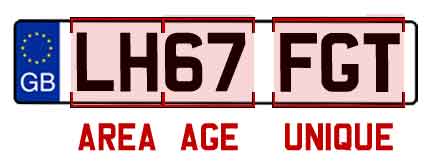In the past vehicle registration numbers were harder to decipher, that all changed in 2001 when UK number plates were updated and took a more simple approach. Now your registration follows this pattern: two letters, followed by two numbers, finished with three more letters. Each part of this format has its own reasoning.

Area Code
The first section (two letters), holds both the area in which the vehicle was originally registered and a DVLA local office, so if a number plate begins with ‘L’ then it was registered in London (this is known as the ‘DVLA memory tag’, you can read more on this here: www.newreg.co.uk/dvla-number-plate-identifiers/
Age Identifier
The second section reflects the year in which the vehicle was registered, splitting the year into two halves. If a car is registered in the first half of the ‘car registration year’ (between March and August) then the two numbers simply show the last two digits of the current year. Although, if the vehicle is bought in the second half (between September and February), then the first digit on the plate reflects the last digit of the current year, while the following digit denotes the decade (6 is shown for the current decade 2010 to 2019). Follow this link to learn more about vehicle registration ages: www.newreg.co.uk/services/new_registration_format_age_identifiers/
Random Letters
Lastly, the three letters that finish off each number plate are also used by the DVLA. These numbers are completely random but allow for a unique reg on vehicles that have the same area code and age identifier. Reading number plates can sometimes be fun and interesting.